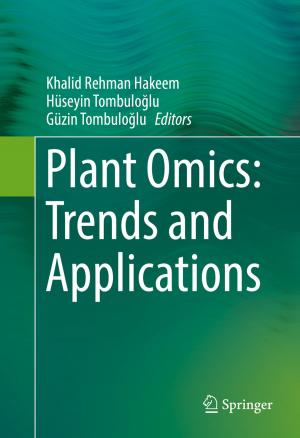Nanomaterials and Plant Potential
Nonfiction, Science & Nature, Science, Biological Sciences, Biochemistry, Botany| Author: | ISBN: | 9783030055691 | |
| Publisher: | Springer International Publishing | Publication: | March 1, 2019 |
| Imprint: | Springer | Language: | English |
| Author: | |
| ISBN: | 9783030055691 |
| Publisher: | Springer International Publishing |
| Publication: | March 1, 2019 |
| Imprint: | Springer |
| Language: | English |
This book discusses the latest developments in plant-mediated fabrication of metal and metal-oxide nanoparticles, and their characterization by using a variety of modern techniques. It explores in detail the application of nanoparticles in drug delivery, cancer treatment, catalysis, and as antimicrobial agent, antioxidant and the promoter of plant production and protection. Application of these nanoparticles in plant systems has started only recently and information is still scanty about their possible effects on plant growth and development. Accumulation and translocation of nanoparticles in plants, and the consequent growth response and stress modulation are not well understood. Plants exposed to these particles exhibit both positive and negative effects, depending on the concentration, size, and shape of the nanoparticles. The impact on plant growth and yield is often positive at lower concentrations and negative at higher ones. Exposure to some nanoparticles may improve the free-radical scavenging potential and antioxidant enzymatic activities in plants and alter the micro-RNAs expression that regulate the different morphological, physiological and metabolic processes in plant system, leading to improved plant growth and yields. The nanoparticles also carry out genetic reforms by efficient transfer of DNA or complete plastid genome into the respective plant genome due to their miniscule size and improved site-specific penetration. Moreover, controlled application of nanomaterials in the form of nanofertilizer offers a more synchronized nutrient fluidity with the uptake by the plant exposed, ensuring an increased nutrient availability. This book addresses these issues and many more. It covers fabrication of different/specific nanomaterials and their wide-range application in agriculture sector, encompassing the controlled release of nutrients, nutrient-use efficiency, genetic exchange, production of secondary metabolites, defense mechanisms, and the growth and productivity of plants exposed to different manufactured nanomaterials. The role of nanofertilizers and nano-biosensors for improving plant production and protection and the possible toxicities caused by certain nanomaterials, the aspects that are little explored by now, have also been generously elucidated.
This book discusses the latest developments in plant-mediated fabrication of metal and metal-oxide nanoparticles, and their characterization by using a variety of modern techniques. It explores in detail the application of nanoparticles in drug delivery, cancer treatment, catalysis, and as antimicrobial agent, antioxidant and the promoter of plant production and protection. Application of these nanoparticles in plant systems has started only recently and information is still scanty about their possible effects on plant growth and development. Accumulation and translocation of nanoparticles in plants, and the consequent growth response and stress modulation are not well understood. Plants exposed to these particles exhibit both positive and negative effects, depending on the concentration, size, and shape of the nanoparticles. The impact on plant growth and yield is often positive at lower concentrations and negative at higher ones. Exposure to some nanoparticles may improve the free-radical scavenging potential and antioxidant enzymatic activities in plants and alter the micro-RNAs expression that regulate the different morphological, physiological and metabolic processes in plant system, leading to improved plant growth and yields. The nanoparticles also carry out genetic reforms by efficient transfer of DNA or complete plastid genome into the respective plant genome due to their miniscule size and improved site-specific penetration. Moreover, controlled application of nanomaterials in the form of nanofertilizer offers a more synchronized nutrient fluidity with the uptake by the plant exposed, ensuring an increased nutrient availability. This book addresses these issues and many more. It covers fabrication of different/specific nanomaterials and their wide-range application in agriculture sector, encompassing the controlled release of nutrients, nutrient-use efficiency, genetic exchange, production of secondary metabolites, defense mechanisms, and the growth and productivity of plants exposed to different manufactured nanomaterials. The role of nanofertilizers and nano-biosensors for improving plant production and protection and the possible toxicities caused by certain nanomaterials, the aspects that are little explored by now, have also been generously elucidated.















